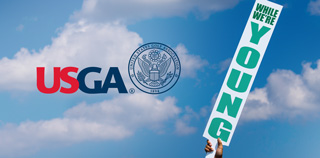by Jeff Skinner
The United States Golf Association continued its efforts to find solutions to the pace of play issue at an all day symposium yesterday at its Far Hill, NJ headquarters. USGA Executive Director, Mike Davis headlined “While We’re Young: Golf Pursuit of A New Paradigm For Pace of Play” which brought together panelists from many varied sectors of the golf industry.
Representatives from the USGA, PGA and LPGA Tours, The PGA of America, course managements companies, golf course superintendents, junior organizations, college professors and more presented data, hard facts and even harder observations about the many causes of slow play.
One of the main topics of the day was trying to understand the root causes for five hour rounds. Even defining “Slow Play” isn’t as cut and dried as we all think. Matt Pringle of the USGA presented the concept of cycle time -how many minutes between when groups finish- which dictates pace of play for the day and needs to be managed not only by the players but by the course management also.
Many ideas were tossed around, even a possible change in the rules of golf to lower the time to search for a lost ball down to three minutes. Ryan Walls of Troon Golf may have found a simple way to jump start golfers to play quicker. All tee time tickets at Troon’s two California courses includes the start time and the expected finish time. Play has improved at one course by 16 minutes and the other by 11 minutes.
Many critics will blame the highest profile golfers, the PGA Tour but even the pros want to play quicker. Davis insists that when you ask the players and give them the opportunity they will indeed speed things up. At the U.S. Open at Merion this year rounds were 11 minutes faster than in 2012, but still a glacial 5:05. But the final round twosomes averaged 3:58 which shows there is hope.
I am all for any initiative that helps speed up play. For my money there is nothing more painful than standing and waiting on every shot and on many of the courses I play regularly that’s the standard routine. Most of my playing partners are relatively quick and we’ll all play ready golf but it doesn’t matter if there is nowhere to go and the course is being backed up by that foursome that doesn’t want to get off the course.
You know that group: four guys with two coolers that hit two from the tee and insist on looking for both of them in the woods for way too long. They’ll light up a cigar, which they only smoke on the course, while they should be hitting to the green. They’ll stop the cart girl and drool over her when it’s their turn to hit and least one of them is on their cell phone all the time. And let’s not forget the three practice swings on every shot and the plumb bob on each putt.
Most of the courses I play, all public, never show any effort in improving the pace of play. At check in it’s not mentioned, there are no rangers and players are left to fend for themselves. It’s not conducive to fast, efficient rounds.
As much as we like to blame the players and that means ourselves, the course operators have to make an effort to improve the pace of play. Some efforts may cost a few dollars like having a ranger on the course. But something like a reminder at check in or signs with expected pace of play won’t cost a thing.
Everyone is responsible to try and shorten that five hour round and all of us have to do our part.

How’s your buddy Mike doing ? And CeCe?
lol